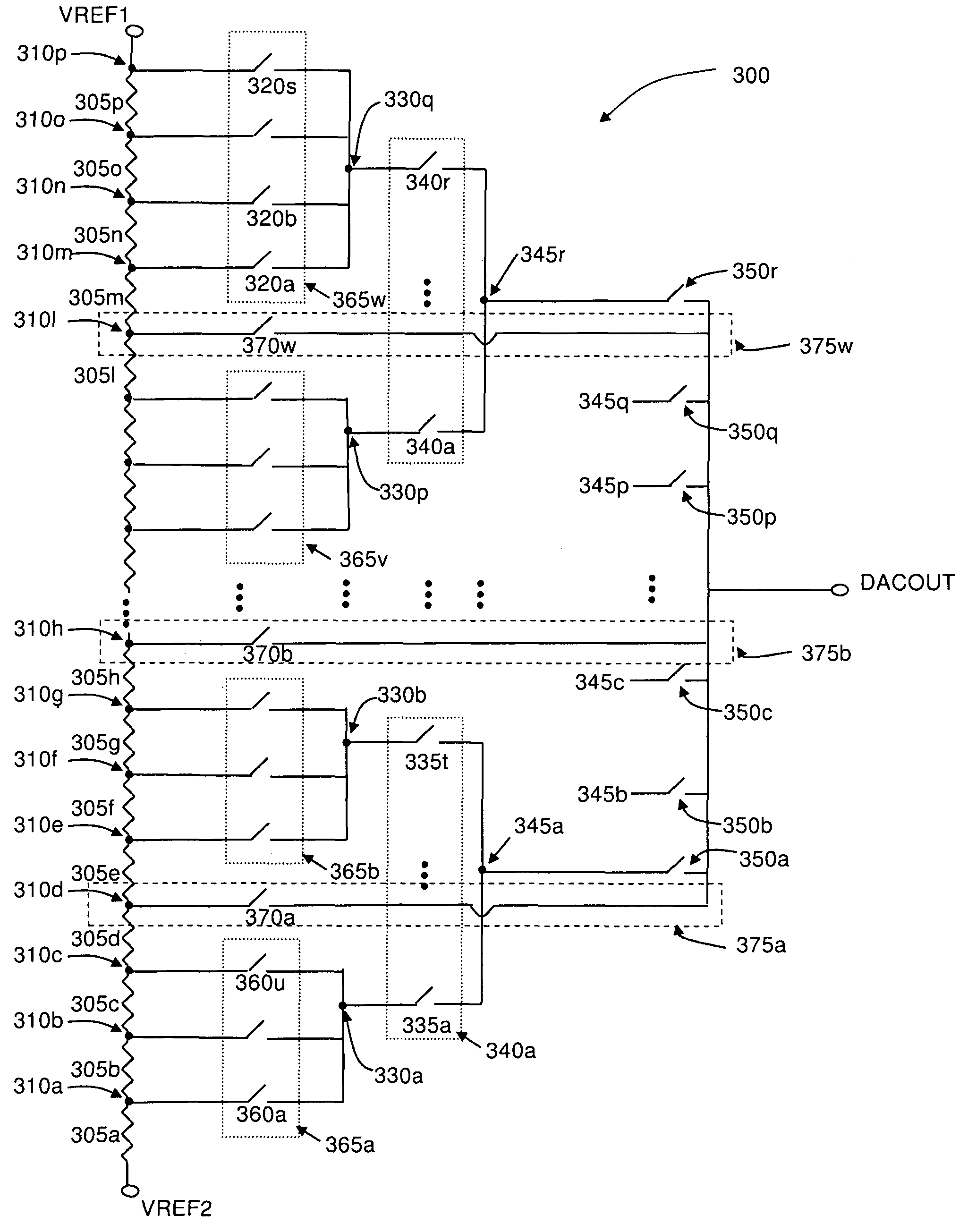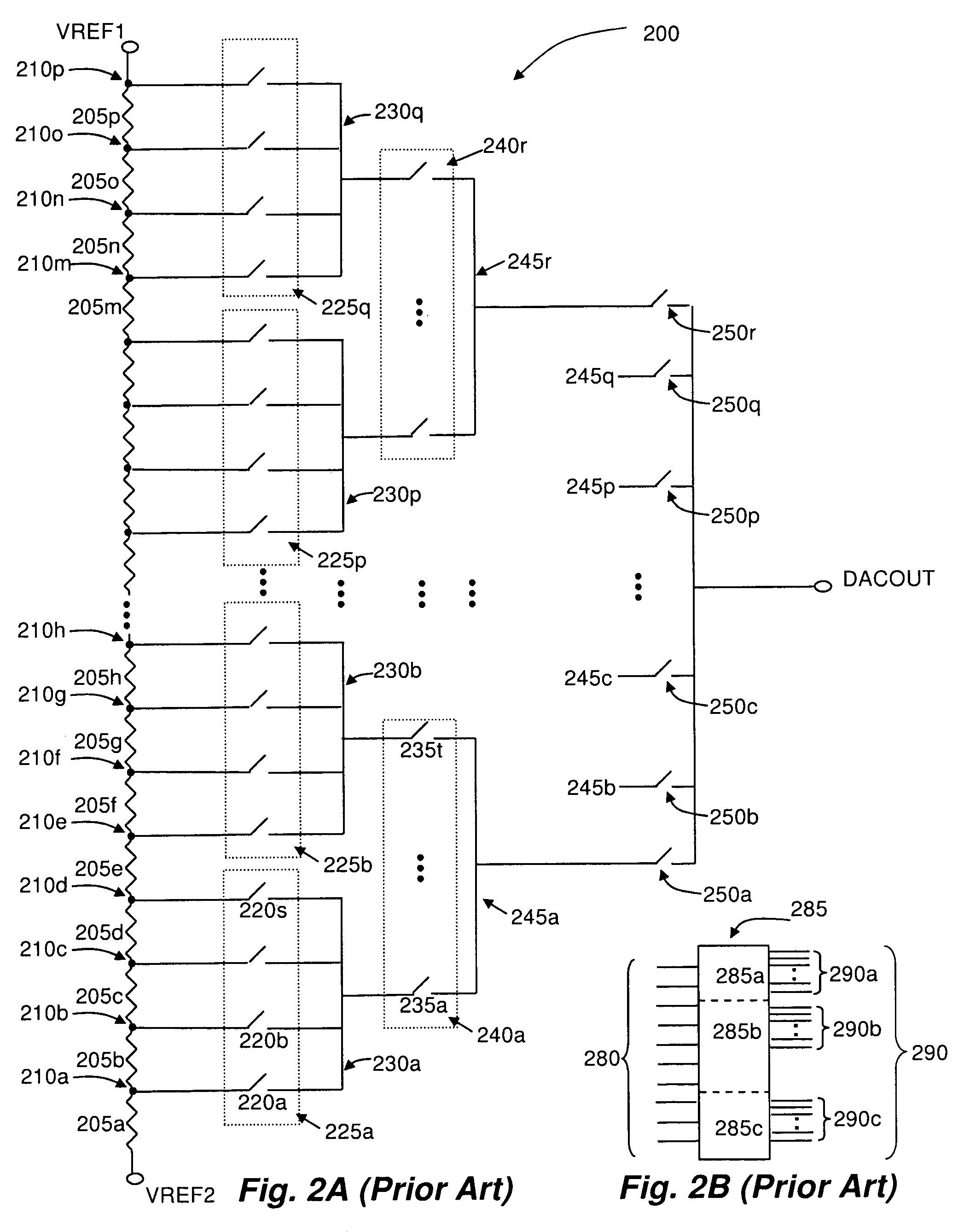Digital to analog converter having fastpaths
a digital to analog converter and fastpath technology, applied in the field of resistor-based digital to analog converters, can solve the problems of limiting the performance of the dac designed for use within successive approximation analog to digital converters (saradcs), impractical dac b>100/b> having an n value larger than 5 and limiting the output capacitance of the dac b>100/b>, etc., to achieve fast access, redu
- Summary
- Abstract
- Description
- Claims
- Application Information
AI Technical Summary
Benefits of technology
Problems solved by technology
Method used
Image
Examples
first embodiment
[0021]the invention is illustrated in FIG. 3A as a DAC hierarchy 300. DAC hierarchy 300 is used for illustrative purposes only and should not be limited to what is shown in FIGS. 3A and 3B, DAC hierarchy 300 includes fastpaths 375, which further include one of selection gates 370, for select voltage divider nodes 310d, 310h, and 310l respectively. Fastpaths 375a, 375b, and 375w connect voltage divider nodes 310d, 310h, and 310l respectively, to DACOUT. The voltage present on the majority of voltage divider nodes 310 must propagate through one or more levels of analog multiplexers: select gates 320, 360, 335, 340, and / or 350 (aka hierarchy mux groups) when addressed or accessed in order to reach DACOUT. However, in DAC hierarchy 300, fastpath 375a, associated with selection gate 370a, connects voltage divider node 310d directly to DACOUT when selection gate 370a is closed.
[0022]Select gates 320, 360, 335, 340, and / or 350 may comprise single transistors or a complimentary twisted tran...
fourth embodiment
[0033]A fourth embodiment is shown in DAC hierarchy 800 of FIGS. 8A and 8B. Within DAC 800, fastpaths 875 provide a connection between two levels of hierarchy, neither of which is any voltage divider node 810, and bypass at least one level of hierarchy (825, 840, or 850). For example, fastpath 870a connects 1st hierarchy output node 830b to DACOUT, bypassing 2nd hierarchy output node 845a. Address decoder 885 operates to recognize fastpath 875 addresses and enable selection gates 825, 840, and / or 850 at each level of hierarchy accordingly. Although FIG. 8A illustrates fastpath 875 connections between a hierarchy node, e.g. 830 or 845 and DACOUT, in embodiments with greater than three levels of decode hierarchy, fastpaths 875 may connect to a node other than DACOUT. Further, while FIG. 8A illustrates fastpath 875 in parallel with the hierarchical access path 830b->835t->845a->850a, one skilled in the art would recognize that elimination of all or a portion of the hierarchical path si...
PUM
 Login to View More
Login to View More Abstract
Description
Claims
Application Information
 Login to View More
Login to View More - R&D
- Intellectual Property
- Life Sciences
- Materials
- Tech Scout
- Unparalleled Data Quality
- Higher Quality Content
- 60% Fewer Hallucinations
Browse by: Latest US Patents, China's latest patents, Technical Efficacy Thesaurus, Application Domain, Technology Topic, Popular Technical Reports.
© 2025 PatSnap. All rights reserved.Legal|Privacy policy|Modern Slavery Act Transparency Statement|Sitemap|About US| Contact US: help@patsnap.com



